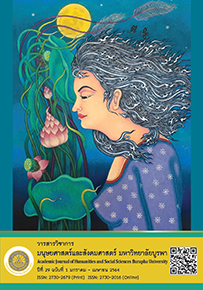The Social Structure and Lifestyles of Thai Prostitutes in Thai Literature during 1937-1966
Main Article Content
Abstract
The study employs a qualitative research approach to investigate the social structure and lifestyles of the prostitutes in Thai literature during the years of 1937 and 1966. Three literatures published in the era including “Ying Khon Chooa (The Prostitute)”, Sanim Soy (The Rust), and Roi Montin (The Flaw)” were selected as the samples. The result of the study indicated that the social structure of the prostitutes in Thai literature was constructed by the conservative, capitalist, and patriarchal characteristics of Thai society. Specifically, the conservative structure of the society constructed the discourses such as “easily laid women,” “misfortune women,” and “purchasable women.” Moreover, the capitalist structure created discourses related to money such as “money is an answer to everything.” Lastly, the patriarchal structure of the society led to the discourses referring men to women’s guardians and masters and women to sexual objects. In terms of the characteristics of the prostitutes in literature, the findings show that prostitution was caused by seduction and poverty. The profession responded to the needs of the family whose wife could not fulfill the sexual desire of husband. Prostitutes also offered therapy for men with unusual sexual desire. The fact that brothels need to seek strategies to convince more customers drove prostitutes to use any forms of their beauty-body, mind, and clothing to seduce visitors.
However, the study indicates that the women were treated with inequality. What is more tragic is that these women had not many choices since they relied on money which could bring about good fortune to their families.
Downloads
Article Details
บทความทุกบทความเป็นลิขสิทธิ์ของวารสารวิชาการมนุษยศาสตร์และสังคมศาสตร์ มหาวิทยาลัยบูรพาเท่านั้น
References
ก. สุรางคนางค์. (2480). หญิงคนชั่ว. กรุงเทพฯ: โอเดียนสโตร์.
กฤตยา อาชวนิจกุล. (2554). เพศวิถีที่กำลังเปลี่ยนแปลงไปในสังคมไทย. ใน วารสารประชากรและสังคม (หน้า 43-65). นครปฐม: ประชากรและสังคม.
กาญจนา แก้วเทพ และสมสุข หินวิมาน. (2551). สายธารแห่งนักคิดทฤษฎีเศรษฐศาสตร์การเมืองกับสื่อสารศึกษา. กรุงเทพฯ: ภาพพิมพ์.
กุหลาบ สายประดิษฐ์. (2518). เบื้องหลังการปฏิวัติ 2475 (พิมพ์ครั้งที่ 3). กรุงเทพฯ: บูรพาแดง.
จันทร์เพ็ญ อมรเลิศวิทย์. (2543). การจัดองค์กรทางสังคม. กรุงเทพฯ: สำนักพิมพ์มหาวิทยาลัยรามคำแหง.
ชลิดาภรณ์ ส่งสัมพันธ์. (2546). ความจริงของเรื่องเพศ: การโต้แย้งสาธารณะเกี่ยวกับเรื่องเพศในสภาผู้แทนราษฎร. กรุงเทพฯ: สำนักงานกองทุนสนับสนุนการวิจัย.
ตรีศิลป์ บุญขจร. (2521). นวนิยายกับสังคมไทย. กรุงเทพฯ: สร้างสรรค์.
ทมยันตี. (2509). รอยมลทิน. กรุงเทพฯ: ณ บ้านวรรณกรรม.
นพมาตร พวงสุวรรณ. (2545). ภาพโสเภณีในนวนิยายไทยกับความเป็นจริงทางสังคม. วิทยานิพนธ์อักษรศาสตรมหาบัณฑิต, สาขาวิชาวรรณคดีเปรียบเทียบ, บัณฑิตวิทยาลัย, จุฬาลงกรณ์มหาวิทยาลัย.
บังอร เทพเทียน. (2552). เพศวิถีภายใต้นโยบายและมาตรการป้องกันโรคเอดส์: การศึกษาเชิงวาทกรรม. ดุษฎีนิพนธ์วิทยาศาสตรดุษฎีบัณฑิต, สาขาวิชาการวิจัยพฤติกรรมศาสตร์ประยุกต์, บัณฑิตวิทยาลัย, มหาวิทยาลัยศรีนครินทรวิโรฒ.
บัญชา มินทรขินทร์. (2504). การโสเภณีในกรุงเทพและธนบุรี. ม.ป.ท.
ปราณี วงษ์เทศ. (2533). ผู้หญิงสยาม บทบาทและสถานภาพของผู้หญิง ร่องรอยจากพิธีกรรมความเชื่อ. ศิลปวัฒนธรรม, 11(5), 108-118.
พรรณี บัวเล็ก. (2543). ลักษณะของนายทุนไทยในช่วงระหว่าง พ.ศ. 2457-2482. กรุงเทพฯ: จุฬาลงกรณ์มหาวิทยาลัย.
พระเมษชัย ใจสำราญ. (2559). แนวคิดปิตาธิปไตยในพระวินัยปิฎก. วิทยานิพนธ์รัฐศาสตรมหาบัณฑิต, สาขาวิชาการปกครอง, คณะรัฐศาสตร์, มหาวิทยาลัยอุบลราชธานี.
พลากร เจียมธีระนาถ. (2554). วาทกรรมชายเป็นใหญ่ในภาพยนตร์ไทยที่ให้ความสำคัญแก่สตรี. วิทยานิพนธ์นิเทศศาสตรมหาบัณฑิต, สาขาวิชาภาพยนตร์, คณะนิเทศศาสตร์, จุฬาลงกรณ์มหาวิทยาลัย.
เพ็ญประภา ภัทรานุกรม. (2558). การศึกษาเพื่อส่งเสริมความเท่าเทียม: ทางออกของความรุนแรงทางเพศ. วารสารร่มพฤกษ์ มหาวิทยาลัยเกริก, 33(1), 1-23.
ภัสสร ลิมานนท์. (2542). บทบาททางเพศ สถานภาพสตรีกับการพัฒนา. กรุงเทพฯ: ม.ป.พ.
’รงค์ วงษ์สวรรค์. (2504). สนิมสร้อย. กรุงเทพฯ: อมรินทร์พริ้นติ้งพับลิชชิ่ง.
วัชระ งามจิตเจริญ. (2552). พุทธศาสนาเถรวาท. กรุงเทพฯ: มหาวิทยาลัยธรรมศาสตร์.
วาริกา นรคิม. (2557). การใช้พื้นที่ทางสังคมของวัดบัวขวัญ จังหวัดนนทบุรี. วิทยานิพนธ์ศิลปศาสตรมหาบัณฑิต, สาขาวิชาการจัดการภาครัฐและภาคเอกชน, บัณฑิตวิทยาลัย, มหาวิทยาลัยศิลปากร.
สุรเดช โชติอุดมพันธ์. (2559). ทฤษฎีวรรณคดีวิจารณ์ตะวันตกในคริสต์ศตวรรษที่ 20. กรุงเทพฯ: สำนักพิมพ์แห่งจุฬาลงกรณ์มหาวิทยาลัย.
อภิวันทน์ อดุลยพิเชฏฐ์. (2544). สถานภาพและบทบาทของผู้หญิงและผู้ชายไทยในอดีต: ภาพสะท้อนจากวรรณกรรมเรื่องขุนช้างขุนแผน. วิทยานิพนธ์ศิลปศาสตรมหาบัณฑิต, สาขาวิชามานุษยวิทยา, บัณฑิตวิทยาลัย, มหาวิทยาลัยศิลปากร.
Foucault, M. (1980). Power/knowledge: Selected interviews and other writing 1972-1977. New York: The Harvester Press.

